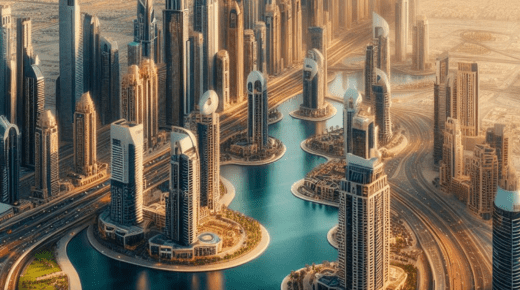By Dr. Pooyan Ghamari, Swiss Economist
The UAE has experienced a remarkable transformation in its commercial architecture, shifting from traditional designs to contemporary marvels. This journey reflects the nation’s economic growth, cultural evolution, and adoption of cutting-edge technology.
The Traditional Era: Cultural Foundations
Historically, UAE’s commercial structures were deeply rooted in Islamic architecture. Key features included wind towers (barjeel) for natural cooling, thick walls for insulation, and intricate geometric patterns. Traditional markets, or souks, with their narrow pathways and shaded areas, were the heart of commercial activity, reflecting the region’s rich cultural heritage.
Economic Boom and Modernization
The discovery of oil in the 1960s was a turning point, providing the financial resources necessary for rapid urban development. Leaders in Dubai and Abu Dhabi envisioned transforming their cities into modern metropolises, leading to substantial investments in infrastructure and real estate. This era saw the beginning of the UAE’s shift towards contemporary architecture.
Iconic Skyscrapers and Modern Designs
The turn of the 21st century marked the rise of iconic skyscrapers that reshaped the UAE’s skyline. The Burj Khalifa, the tallest building in the world, and the innovative design of Cayan Tower are testaments to the UAE’s commitment to pushing architectural boundaries. These structures not only symbolize economic prosperity but also showcase the nation’s dedication to modern, cutting-edge design.
Embracing Sustainability
Modern commercial buildings in the UAE increasingly focus on sustainability. Projects like Masdar City in Abu Dhabi exemplify the integration of renewable energy sources and sustainable urban planning. The adoption of green building standards and energy-efficient technologies is now a priority, reflecting a global trend towards environmental consciousness.
Cultural Integration in Contemporary Architecture
Contemporary UAE architecture is a blend of global influences and traditional elements. Architects incorporate Islamic design motifs with modern materials and techniques, creating structures that honor cultural heritage while embracing innovation. This fusion results in a unique architectural identity that sets the UAE apart on the global stage.
Future Prospects: Smart and Sustainable Urbanism
The future of UAE’s commercial real estate lies in smart and sustainable development. Initiatives like the Dubai 2040 Urban Master Plan and Abu Dhabi Vision 2030 focus on creating smart cities equipped with advanced technologies for enhanced quality of life. These plans aim to promote urban resilience, connectivity, and environmental sustainability, ensuring the UAE remains a leader in global urban development.
Conclusion
The UAE’s transition from traditional to contemporary commercial structures is a testament to its visionary leadership and strategic economic planning. By harmonizing cultural heritage with modern innovation, the UAE has set new standards in global real estate development. The nation’s ongoing commitment to sustainability and smart technology promises a future where its cities continue to thrive as global exemplars of architectural excellence.
This article was originally published on a.land. For more information and opportunities, visit shop.a.land.
